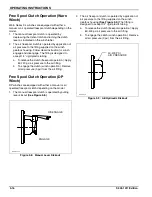
OPERATING INSTRUCTIONS
3-7
Towing the Semitrailer
CAUTION
Driving the towing vehicle with the semitrailer coupled
behind requires constant attention to the overall length of
the combination. The “hinged-in-the-middle”
configuration of the tractor and semitrailer, load, and
weight affect performance. Turning, passing,
acceleration, braking, stopping, and backup require
special considerations. When executing steep grades or
turning tight curves, the semitrailer must not be allowed
to push the towing vehicle, or jack knifing the semitrailer
with the towing vehicle may result. Application of the
semitrailer brakes to keep the semitrailer in tow will help
prevent this pushing. Braking should begin before
descending a hill or attempting a curve, to assure control.
1.
Make a moving test of the semitrailer brakes at low
and medium speeds before traveling at highway
speed.
a.
The Anti-Lock Brake System (ABS) warning
lamp mounted at left rear side of the semitrailer
should come on when power is supplied to the
ABS by turning the tractor keyswitch on. The
warning lamp should go off once the semitrailer
exceeds 4 mph. If the warning lamp does not go
off, a fault exists in the semitrailer ABS. Once the
vehicle speed exceeds 4 mph, the light should
remain off unless a fault occurs or the keyswitch
is turned off, then on again.
CAUTION
2.
Monitor the air pressure gauge on the dash of the
towing vehicle. Pressure should not fall below 90 psi
at any time.
3.
The semitrailer wheels track to the inside of the
towing vehicle during turns. Thus, turning corners
requires a wide swing to prevent “curb hopping”, and
to allow the semitrailer wheels to clear any obstacle
on the inside of the corner.
4.
To stop, use a gradual and smooth application of
brakes. If grabbing occurs, apply less pressure -
grabbing brakes are not efficient.
WARNING
5.
Backing should be done with care. Tail overhang,
semitrailer length, and allowable space must be
taken into consideration when backing the
semitrailer.
Parking the Trailer
1.
Position truck/semitrailer rig on a level, solid surface.
2.
Set the
PARKING BRAKE
,
not the semitrailer
hand brake
, and check for proper brake holding.
3.
Chock wheels of semitrailer.
4.
Check for any air leaks in lines, relay valve, brake
pods, or any other air system component.
WARNING
When operating semitrailer, do not back over
curb. This will cause severe damage to
undercarriage and undercarriage cylinder.
If a fault exists in the semitrailer ABS, normal
braking will occur, but wheels may lock. Service
the ABS as soon as possible.
Always check behind and under the truck and
semitrailer for persons or objects before moving.
Failure to check can lead to serious personal
injury or death to others, or damage to property.
When leaving the semitrailer unattended,
position all hydraulic controls to the neutral or
“off” position and shut off the hydraulic engine
power supply, or disconnect the tractor hydraulic
hook-up.
Summary of Contents for 425B Series
Page 2: ......
Page 6: ...iv F 543 1011 Edition...
Page 14: ...2 6 F 543 1011 Edition STANDARD SPECIFICATIONS...
Page 26: ...3 12 F 543 1011 Edition OPERATING INSTRUCTIONS Figure 3 7 Steps for Loading and Unloading...
Page 32: ...3 18 F 543 1011 Edition OPERATING INSTRUCTIONS Figure 3 12 Dock Leveler Operation...
Page 61: ...MAINTENANCE AND LUBRICATION 4 21 Figure 4 13 Axle and Brake Assembly...
Page 76: ...4 36 F 543 1011 Edition MAINTENANCE AND LUBRICATION Page Intentionally Blank...
Page 86: ...5 10 F 543 1011 Edition TROUBLESHOOTING GUIDE...
Page 87: ......
















































